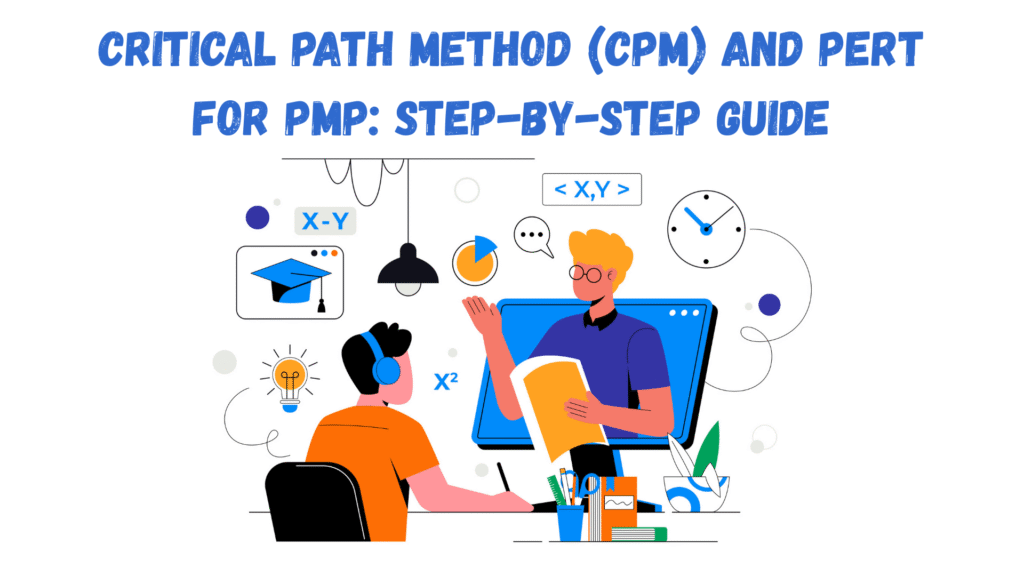
Critical Path Method (CPM) and PERT for PMP: Step-by-Step Guide
Project scheduling lies at the heart of the Project Management Professional (PMP) framework. Among the techniques used for managing time and resources, two stand out: the Critical Path Method (CPM) and the Program Evaluation and Review Technique (PERT). Both are essential tools for project managers, especially those preparing for the PMP certification. This blog will walk you step by step through their foundations, applications, and integration into real-world project management.
Understanding the Basics
Before diving into the methods, it is important to understand why they matter. Projects are complex networks of tasks, dependencies, and deadlines. Without a clear schedule, teams risk delays, resource conflicts, and cost overruns. CPM and PERT help avoid these issues by offering structured ways to analyze and control project timelines.
- Critical Path Method (CPM): A deterministic technique that identifies the longest path of dependent tasks in a project. This path determines the minimum project duration.
- Program Evaluation and Review Technique (PERT): A probabilistic technique that accounts for uncertainty by using optimistic, pessimistic, and most likely estimates for task durations.
Step 1: Defining Activities
Both CPM and PERT start with listing all the activities that make up the project. Each task should be broken down to a manageable level with clear deliverables. For example, in a construction project, activities might include site preparation, foundation laying, framing, electrical wiring, and finishing.
Step 2: Sequencing Activities
Next, establish dependencies. Some tasks must finish before others can start, while some may run in parallel. This sequencing forms the foundation of the project network. Techniques like the Precedence Diagramming Method (PDM) are often used to illustrate these dependencies.
Step 3: Estimating Activity Durations
Here lies a key difference between CPM and PERT.
- In CPM, durations are estimated as fixed values, often based on past experience or standard practices.
- In PERT, three estimates are used:
- Optimistic (O): The shortest possible time if everything goes well.
- Most Likely (M): The time under normal conditions.
- Pessimistic (P): The longest time under challenging conditions.
- Optimistic (O): The shortest possible time if everything goes well.
The expected duration (TE) is then calculated using the formula:
TE = (O + 4M + P) / 6
This probabilistic approach gives a more realistic timeline, especially for uncertain projects.
Step 4: Building the Network Diagram
Using the activity list and dependencies, project managers create a network diagram. This visual map of activities helps identify paths through the project. Tools like MS Project, Primavera, or even simple drawing software can be used for this step.
Step 5: Calculating the Critical Path
In CPM, the critical path is the longest sequence of dependent tasks that determines the shortest possible duration of the project. Delays on this path directly delay the project completion date.
- Calculate Earliest Start (ES) and Earliest Finish (EF) for each task using forward pass analysis.
- Calculate Latest Start (LS) and Latest Finish (LF) using backward pass analysis.
- Identify tasks with zero slack or float. These tasks lie on the critical path.
In PERT, the same approach applies, but activity durations are based on expected values rather than single estimates.
Step 6: Analyzing Float
Float (or slack) represents flexibility. Tasks not on the critical path usually have some float, meaning they can be delayed without affecting the overall project duration. Understanding float helps managers allocate resources effectively and manage risks.
Step 7: Determining Project Duration and Variance (PERT Focus)
In PERT, once the expected time for each activity is determined, the variance is calculated using the formula:
Variance = [(P – O) / 6]²
The total variance of the critical path provides insight into the uncertainty of the project duration. This statistical approach allows managers to calculate probabilities of meeting deadlines.
Step 8: Monitoring and Updating
Both CPM and PERT are living tools. As the project progresses, actual performance data should update the network. Recalculating paths and floats ensures that managers always have an up-to-date picture of the schedule.
CPM vs. PERT: Key Differences
- Nature of Estimates: CPM uses fixed times; PERT uses probabilistic estimates.
- Application: CPM is best for projects with well-known tasks (construction, manufacturing). PERT suits R&D or innovation projects where uncertainty is high.
- Focus: CPM emphasizes critical tasks and deadlines. PERT emphasizes uncertainty and probability.
Real-World Applications
- Construction Projects: CPM ensures strict adherence to deadlines for deliverables like foundations, structures, and inspections.
- Software Development: PERT accounts for uncertainty in tasks such as debugging, integration, and testing.
- Research Projects: PERT allows estimation of timeframes when outcomes and timelines are unpredictable.
- Event Management: CPM helps map out tasks such as logistics, vendor management, and stage setups.
Integrating CPM and PERT in PMP Preparation
For PMP candidates, mastering CPM and PERT is crucial. Questions often test knowledge of formulas, critical path calculations, and probability analysis. Practicing with real-world case studies strengthens understanding.
- Focus on network diagram creation and analysis.
- Practice calculating floats, expected durations, and variances.
- Study scenarios where CPM or PERT would be more suitable.
Conclusion
The Critical Path Method and PERT are more than just scheduling tools. They are strategic lenses that allow project managers to see both the structure and the uncertainty of projects. By mastering them, PMP candidates and practicing managers gain sharper control over timelines, risks, and resources. A project’s success often depends on this clarity.